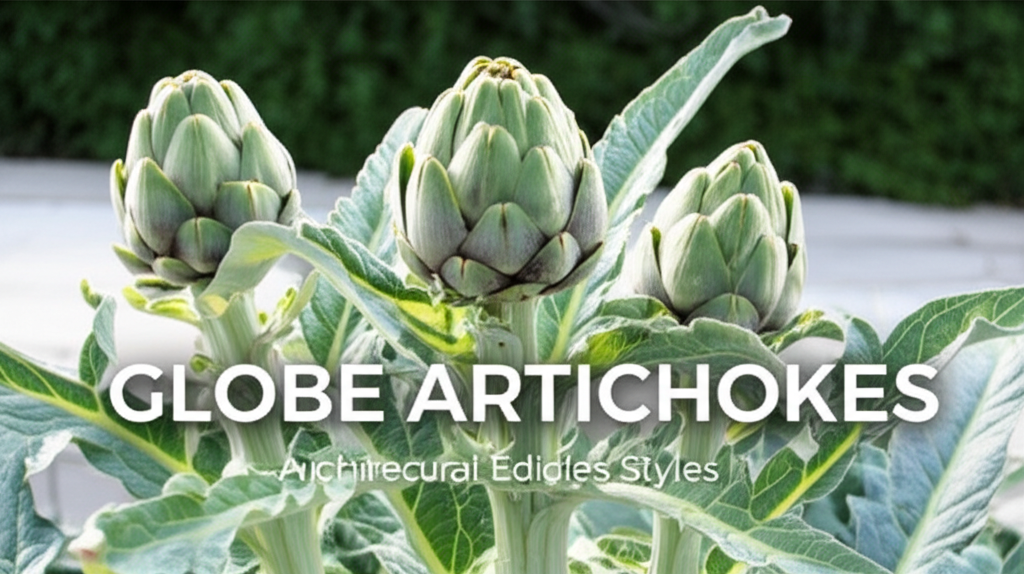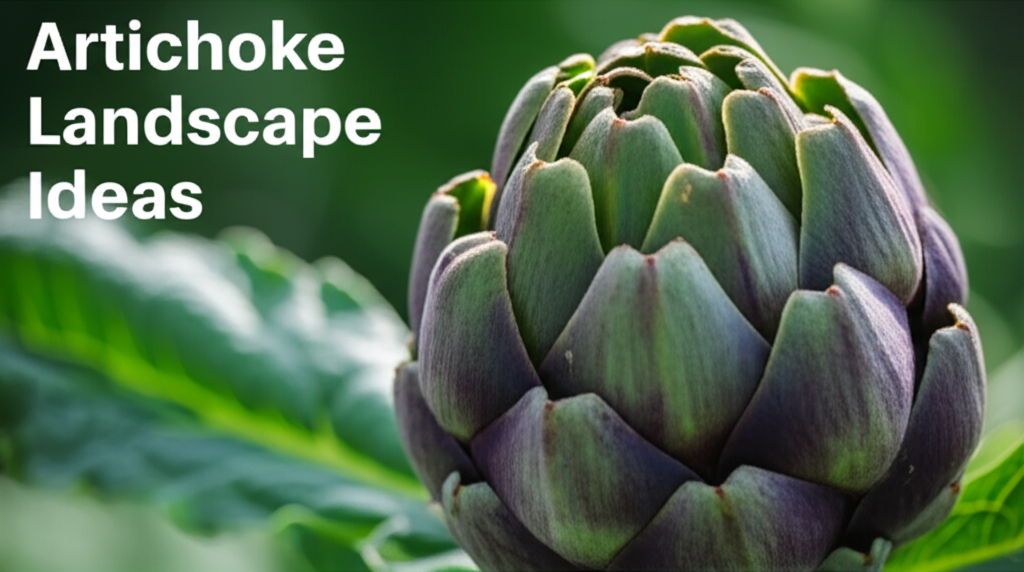The Rise of the Edible Ornamental: Globe Artichokes in Modern Gardens
For centuries, the globe artichoke (Cynara cardunculus var. scolymus) has been prized for its culinary delights. However, in recent years, this architectural marvel has transcended the kitchen garden and firmly planted itself as a star player in contemporary landscape design trends. Once relegated to the realm of the purely functional, edible plants are now celebrated for their aesthetic appeal, and the globe artichoke, with its dramatic form, silvery foliage, and striking bloom, is a perfect embodiment of this shift. This article explores why the globe artichoke is a sought-after element in modern landscaping, its unique contributions to garden aesthetics, and practical considerations for its integration.
Aesthetic Powerhouse: Form, Foliage, and Flower
The globe artichoke’s appeal lies in its multifaceted visual impact. It’s not just a plant; it’s a living sculpture.
Form and Structure
The inherent structure of the globe artichoke is its most compelling attribute. It grows into a large, bushy mound, often reaching 3-4 feet in height and width. This substantial presence makes it an excellent anchor plant for garden beds, providing a strong vertical and horizontal element that defines spaces. The deeply cut, deeply lobed leaves, often silvery-green or grey, create a soft, textural contrast against more finely textured plants. This dramatic foliage can create a focal point from the moment it emerges in spring until the first hard frost.
Silvery Foliage
The color of the globe artichoke’s foliage is a significant design advantage. The silvery sheen is not only visually appealing but also reflects light beautifully, making it stand out even in shaded areas. This cool-toned foliage complements a wide range of colors, from vibrant reds and oranges to soft blues and purples. Its monochromatic beauty allows it to harmonize with diverse planting schemes, acting as a sophisticated backdrop or a statement piece in its own right.
The Captivating Flower
While the edible bud is the primary reason for cultivation, the flowering stalk of the globe artichoke is a spectacle in itself. Once established, the plant sends up a tall, often branched stalk topped with large, bud-like flower heads. These develop into stunning, thistle-like blooms, typically a vibrant purple or violet, though some cultivars may exhibit other shades. The unopened buds are equally captivating, resembling a prehistoric structure. Even after the edible portion is harvested, the spent flower heads, often left on the plant, offer continued visual interest through winter, providing textural contrast and attracting beneficial insects.
Globe Artichokes in Key Landscape Design Trends

The globe artichoke’s adaptability and visual appeal make it a natural fit for several prominent landscaping trends.
The Edible Landscape Movement
This is arguably where the globe artichoke shines brightest. As homeowners increasingly seek to integrate food production into their ornamental gardens, plants that offer both beauty and bounty are highly valued. The globe artichoke perfectly straddles this line, providing a spectacular ornamental feature while simultaneously offering delicious, nutritious produce. Its large size and striking appearance mean it doesn’t look out of place amongst flowering perennials or shrubs.
Low-Water and Drought-Tolerant Gardens
Once established, globe artichokes are remarkably drought-tolerant, making them an excellent choice for xeriscaping and Mediterranean-style gardens, which emphasize plants that thrive with minimal water. Their silvery, somewhat fuzzy foliage is characteristic of many plants adapted to arid or semi-arid conditions, further enhancing their suitability for these designs.
Architectural Planting
The strong, sculptural form of the globe artichoke lends itself perfectly to creating architectural interest in the garden. It can be used as a specimen plant, planted in a geometric arrangement, or used to create dramatic mass plantings. Its bold silhouette provides a sense of structure and grandeur, contributing to a sophisticated and modern garden aesthetic.
Cottage Garden Revival with a Modern Twist
While traditionally associated with Mediterranean and more formal styles, the globe artichoke is also finding its way into more relaxed, cottage-style gardens. Its naturalized form and somewhat wild appearance, combined with its edible nature, offer a rustic charm. When juxtaposed with softer, flowering perennials, its architectural form provides a grounding element, preventing the garden from becoming too unstructured.
Coastal Gardens
The globe artichoke’s tolerance for salt spray and its ability to withstand windy conditions make it a suitable candidate for coastal landscapes. Its silvery foliage can also complement the natural palette of coastal environments, which often feature muted tones and hardy, salt-tolerant vegetation.
Key Facts and Comparison: Globe Artichoke vs. Other Ornamental Edibles
To understand the globe artichoke’s unique position, it’s helpful to compare it with other popular ornamental edibles.
| Feature | Globe Artichoke (Cynara scolymus) | Ornamental Kale/Cabbage | Blue Agave (Agave tequilana) | Fennel (Foeniculum vulgare ‘Purpureum’) |
|---|---|---|---|---|
| Primary Aesthetic Appeal | Dramatic architectural form, silvery foliage, large thistle-like blooms. | Bold, ruffled foliage in vibrant colors (purple, pink, white). | Striking, succulent rosette shape, architectural presence. | Feathery, anise-scented foliage in bronze/purple hues. |
| Edible Part | Flower buds (heart and base of scales). | Leaves (often used in culinary contexts). | Agave nectar (from sap), flower stalk (cooked). | Fennel bulb, fronds, seeds (anise flavor). |
| Size | 3-4 ft tall and wide. | 1-1.5 ft tall and wide. | 2-5 ft tall and wide (flower stalk much taller). | 3-5 ft tall, 2-3 ft wide. |
| Water Needs | Low to moderate once established. | Low to moderate. | Very low (drought tolerant). | Low to moderate. |
| Sun Exposure | Full sun. | Full sun to partial shade. | Full sun. | Full sun to partial shade. |
| Hardiness Zone | Zones 7-10 (often perennialized in cooler zones with protection). | Zones 2-11 (typically grown as annuals in colder climates). | Zones 9-11 (tender perennial, often grown in containers in cooler climates). | Zones 4-9 (often grown as annuals in colder climates). |
| Overall Impact | Bold, sculptural, Mediterranean feel. | Colorful, textured, often used for seasonal color. | Modern, sculptural, desert aesthetic. | Soft, airy, fine texture, dramatic color. |
Integrating Globe Artichokes into Your Landscape: Practical Considerations
While their aesthetic appeal is undeniable, successful integration requires thoughtful planning.
Site Selection
Globe artichokes thrive in full sun and require well-drained soil. They can tolerate a range of soil types but perform best in fertile, loamy conditions. Poor drainage can lead to root rot, especially in wetter climates. Ensure the chosen location provides ample space for their mature size.
Climate and Hardiness
Globe artichokes are generally hardy in USDA zones 7-10. In cooler climates (zones 5-6), they can often be grown as annuals or perennialized with protection. Overwintering methods include mulching heavily with straw or compost, or digging up the plants and storing them in a cool, frost-free location.
Soil Preparation
Amend the soil with compost or well-rotted manure before planting to ensure good fertility and drainage. Raised beds are an excellent option in areas with heavy clay or poor drainage.
Planting and Spacing
Start from seed indoors 6-8 weeks before the last frost or purchase seedlings. Plant them in their final location after the danger of frost has passed. Space plants 3-4 feet apart to allow for their mature spread.
Watering and Fertilizing
Water regularly, especially during dry periods, though established plants are drought-tolerant. For optimal bud production, provide consistent moisture. Feed with a balanced fertilizer in early spring and again after harvesting any buds.
Pest and Disease Management
Globe artichokes are generally robust, but can be susceptible to aphids and slugs. Companion planting with rosemary or mint may help deter aphids. Consider hand-picking slugs or using eco-friendly slug bait. Fungal diseases can occur in damp conditions; ensure good air circulation.
Harvesting
Harvest buds when they are plump and tight, before the scales begin to separate. Cut the stalk with a sharp knife, leaving a few inches of stem attached. Continuous harvesting encourages more bud formation.
Pros and Cons of Using Globe Artichokes in Landscaping
A balanced perspective is crucial when making planting decisions.
| Pros | Cons |
|---|---|
| Striking Architectural Form: Provides strong visual structure and a focal point. | Large Size: Requires ample space and careful placement to avoid overwhelming smaller gardens. |
| Beautiful Silvery Foliage: Adds texture and color, complements a wide range of plant palettes. | Can be Short-Lived as a Perennial: In colder zones, may require protection or be treated as an annual. |
| Edible Produce: Offers delicious, sought-after food in addition to ornamental value. | Can be Prone to Pests: Aphids and slugs can be problematic if not managed. |
| Drought Tolerance: Suitable for low-water gardens once established. | Prefers Well-Drained Soil: Can struggle in waterlogged conditions, requiring careful site selection or soil amendment. |
| Winter Interest: Spent flower heads provide textural contrast throughout the colder months. | Longer Establishment Period: May take a year or two to reach full maturity and produce abundant harvests. |
| Attracts Pollinators: The vibrant flowers are a magnet for bees and other beneficial insects. | Can be Thorny: Some varieties have sharp spines on the bracts of the flower buds, requiring caution during handling. |
Creative Combinations and Design Applications
The versatility of the globe artichoke allows for innovative planting partnerships.
Mediterranean-Inspired Gardens
Pair globe artichokes with other drought-tolerant, sun-loving plants such as lavender (Lavandula spp.), rosemary (Rosmarinus officinalis), sage (Salvia spp.), ornamental grasses, and olive trees. Their silvery foliage will create a harmonious palette with these classic Mediterranean choices.
Modern Minimalist Gardens
Use globe artichokes as bold sculptural elements in minimalist designs. Plant them in simple geometric arrangements or as single specimens against a backdrop of gravel or smooth stones. Their dramatic form is enough to make a statement without the need for extensive accompanying plantings.
Cottage Gardens
For a touch of rustic charm, combine globe artichokes with traditional cottage garden flowers like hollyhocks (Alcea rosea), delphiniums (Delphinium spp.), and peonies (Paeonia spp.). The artichoke’s strong form will provide structure amidst the softer, blowier blooms.
Mixed Borders
In mixed perennial borders, place globe artichokes towards the back or middle to provide height and a strong structural element. Their silvery foliage can act as a bridge between intensely colored flowers and softer green foliage. Consider pairing them with plants that have contrasting leaf textures, such as hostas or ferns, for added dimension.
As a Specimen Plant
A single globe artichoke planted in a prominent location, perhaps near an entrance or on a lawn, can serve as a dramatic focal point. Ensure it has ample space to reach its full potential.
Conclusion: A Bold and Beautiful Choice for Modern Gardeners
The globe artichoke is more than just a food source; it’s a horticultural asset that brings significant aesthetic and ecological value to the landscape. Its architectural presence, distinctive silvery foliage, and spectacular blooms make it a compelling choice for gardeners looking to embrace edible landscaping, low-water design, and bold, contemporary aesthetics. By understanding its needs and appreciating its unique attributes, the globe artichoke can transform any garden into a visually captivating and productive space. As design trends continue to favor plants that offer multiple benefits, the globe artichoke is set to remain a celebrated and sought-after element in gardens for years to come.


